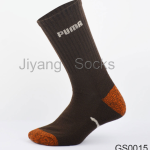Although true tube socks are knitted in the shape of a tube, some manufacturers make versions
with a knitted heel and a more heavily padded sole, for comfort. These socks share the ribbed cuff
of traditional tube sock, which prevents the sock from sliding down the leg. As the socks and cuff
gradually lose elasticity, however, they will start to slip when worn, as the ribs become stretched out.
Some people wear these socks simply because they are comfortable, and because they provide a
layer of insulation in cold weather. Others view theem as a sort of fashion statement, and one may
see tube socks on certain groups in various communities, who wear them as part of an overall
style or look. In the late 1990s, for example, many skaters began adopting them as ¡°old school
socks,¡± sporting them along with other skate clothes.
Because tube socks are so simple to knit, the basic pattern has probably been made for
centuries. Certainly during the First World War, an astounding number were produced as many
countries contributed knitting to the war effort. The Red Cross, for example, encouraged both men
and women at home to knit socks for soldiers in the trenches, since a solid pair of socks could
insulate feet from extreme cold and painful blisters. Many knitters started making them because
they were a fast knit and because a poorly turned heel can cause pain in the wearer, so these
socks would have been more comfortable.




